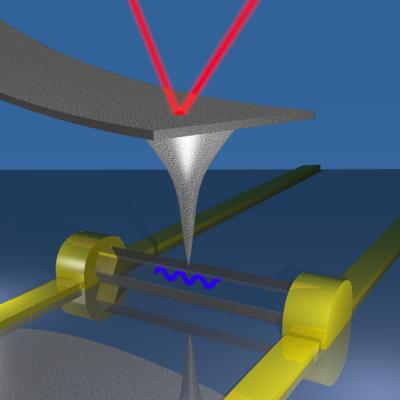A research team from the Northwestern University has found that one-dimensional materials such as individual gallium nitride nanowires demonstrate powerful piezoelectricity, a three-dimensional phenomenon caused by the application of mechanical stress.
 This is a diagram of a single nanowire piezoelectricity. (Image courtesy Horacio Espinosa)
This is a diagram of a single nanowire piezoelectricity. (Image courtesy Horacio Espinosa)
The research team, headed by Horacio Espinosa from the Northwestern University McCormick School of Engineering and Applied Science, has reported its results in Nano Letters. Gallium nitride is a most commonly used semiconducting material in optoelectronic components, including LEDs and blue lasers. The most recent demonstration is gallium nitride-based nanogenerators, which can transfer mechanical energy such as biomechanical motion into electrical energy.
Espinosa’s team believed that nanowires can demonstrate piezoelectricity in three dimensions. The team’s objective was to get all piezoelectric constants for single nanowires, like that of the bulk materials, he added.
According to the study results, single gallium nitride nanowire measuring 60 nm demonstrates piezoelectric characteristic in three dimensions up to six folds higher than that of its bulk counterpart. Since the charge production varies linearly with the piezoelectric constants, the nanowires can convert mechanical energy into electrical energy at an efficiency six folds better than that of their bulk materials.
The research team developed a scanning probe microscopy-based method powered by the accurate displacement measurement functionality of an atomic force microscope. It measured microscopic displacements down to the picometer range by applying an electric field in various directions in an individual nanowire. These findings are useful particularly for gallium nitride nanowire-based nanogenerators that can be used as a power source for self-powered nanodevices.